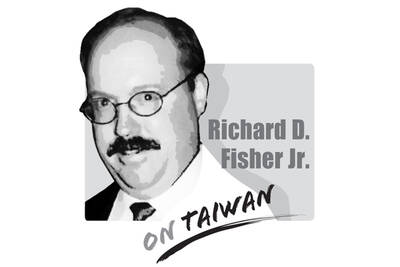Few would deny that former minister of foreign affairs Mark Chen (陳唐山) is a member of the pro-Taiwanese independence old guard.
The Chinese Nationalist Party (KMT) would certainly agree that he is — which is why it has blacklisted him — as would independence advocates living in the US, the US government and the US Congress, which he addressed as a representative of World United Formosans for Independence.
THE ‘STATUS QUO’
It was for this reason that members of the new wave of independence advocates raised their eyebrows when Chen told US media that maintaining the cross-strait “status quo” is a way to protect the nation and that mentioning independence is a step too far.
The new wave of independence supporters believe that President Tsai Ing-wen’s (蔡英文) policy of maintaining the cross-strait “status quo” was the reason for her drubbing in the recent local elections.
However, one Washington Post columnist visiting Taiwan said that everywhere he went, it seemed that everybody he met supported the “status quo,” just as Chen had.
NAMES ARE NOT ENOUGH
It goes without saying that it is entirely legitimate and reasonable to dispose of an imposed national title — if there were not a high price to pay for doing so.
However, it would be misguided to presume that simply changing the name of a country would gain that country official recognition.
The reason that Taiwan’s independent status has failed to secure it recognition as a country is purely political in nature: It has little to do with the name itself.
For 30 years, the US refused to recognize the government of the People’s Republic of China (PRC) that had established itself in China, continuing to recognize instead the exiled government of the Republic of China (ROC) on Taiwan, while not recognizing that the latter’s territory extended to China.
The name of the country was not a factor in deciding whether to recognize the legitimacy of a government.
However, the continuation of the “status quo” could become an important consideration of whether or not to recognize a country.
When the US abandoned the ROC in favor of establishing diplomatic relations with the PRC, then-US president Jimmy Carter expected the KMT to surrender within three or four years — perhaps seven or eight years at the most. With that, the “Taiwan problem” would have been resolved.
Over the four decades that have passed since then, the exiled ROC government has been transformed into a representative, legitimate constitutional government and, over the past 20 years, calls for the US to recognize Taiwan’s status have gradually become louder.
RECOGNITION
That Taiwan’s status remains unrecognized is not the fault of Taiwan: It is because the US and the international community have capitulated to China.
With the long-term maintenance of the “status quo,” coupled with China’s refusal to act in accordance with international norms and its hegemonic ambitions, the time is now ripe for the US to re-examine when would be the appropriate time to recognize Taiwan’s national status.
For 40 years now, the US has failed to officially recognize a political entity that legally belongs to no other country and which has consistently maintained an independent existence. That, my friends, is a step too far.
James Wang is a media commentator.
Translated by Paul Cooper
Lockheed Martin on Tuesday responded to concerns over delayed shipments of F-16V Block 70 jets, saying it had added extra shifts on its production lines to accelerate progress. The Ministry of National Defense on Monday said that delivery of all 66 F-16V Block 70 jets — originally expected by the end of next year — would be pushed back due to production line relocations and global supply chain disruptions. Minister of National Defense Wellington Koo (顧立雄) said that Taiwan and the US are working to resolve the delays, adding that 50 of the aircraft are in production, with 10 scheduled for flight

Victory in conflict requires mastery of two “balances”: First, the balance of power, and second, the balance of error, or making sure that you do not make the most mistakes, thus helping your enemy’s victory. The Chinese Communist Party (CCP) has made a decisive and potentially fatal error by making an enemy of the Jewish Nation, centered today in the State of Israel but historically one of the great civilizations extending back at least 3,000 years. Mind you, no Israeli leader has ever publicly declared that “China is our enemy,” but on October 28, 2025, self-described Chinese People’s Armed Police (PAP) propaganda
Chinese Consul General in Osaka Xue Jian (薛劍) on Saturday last week shared a news article on social media about Japanese Prime Minister Sanae Takaichi’s remarks on Taiwan, adding that “the dirty neck that sticks itself in must be cut off.” The previous day in the Japanese House of Representatives, Takaichi said that a Chinese attack on Taiwan could constitute “a situation threatening Japan’s survival,” a reference to a legal legal term introduced in 2015 that allows the prime minister to deploy the Japan Self-Defense Forces. The violent nature of Xue’s comments is notable in that it came from a diplomat,
The artificial intelligence (AI) boom, sparked by the arrival of OpenAI’s ChatGPT, took the world by storm. Within weeks, everyone was talking about it, trying it and had an opinion. It has transformed the way people live, work and think. The trend has only accelerated. The AI snowball continues to roll, growing larger and more influential across nearly every sector. Higher education has not been spared. Universities rushed to embrace this technological wave, eager to demonstrate that they are keeping up with the times. AI literacy is now presented as an essential skill, a key selling point to attract prospective students.